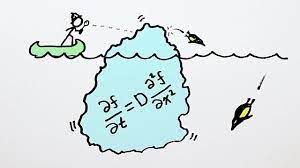One thing that's astounding about Einstein's publications in 1905
爱因斯坦在1905年发表的几篇论文 有一点相当令人称奇
is that they spanned such a large range of physics:
那就是它们所涉及的物理学领域相当之广
after illuminating the quantum nature of light by explaining the photoelectric effect in March,
他在三月以解释光电效应阐述了光的量子本质之后
April saw Einstein turned to something apparently more mundane: particles suspended in fluids.
又在4月将目光投向了更普遍的东西:悬浮在流体中的微粒

In particular, if you look at tiny particles in water, or dust motes in the air,
如果你仔细观察水中的微粒或空气中的雾霾
you'll see that they jitter about in a very odd and random way.
你会发现它们在不停地随机抖动
That is, it appears odd and random unless you believe that
对这种怪异的随机运动只有一种解释
the air or water itself is made up of even smaller particles called atoms or molecules,
就是空气和水是由更小的原子和分子构成的
which just bounce off of each other according to very simple rules.
它们依据简单的规律碰撞和反弹
This is called Brownian motion,
这被称为"布朗运动"
despite the fact that botanist Brown wasn't the first to discover it,
尽管这不是植物学家布朗首先发现的
and similarly Einstein wan't the first to describe it mathematically…
巧合的是 爱因斯坦也不是第一个用数学描述它的人
but he did draw the conclusion that the mathematical description of Brownian motion
但他的确根据布朗运动的数学描述得出了重要的结论
is evidence for the existence of atoms even if you can't see them directly,
原子是存在的 即使我们不能看到它们
and then he cleverly derived how big atoms should be just based on how much the Brownian particles move.
随后 爱因斯坦又机智地根据布朗运动的规律计算出了原子的大小
That's like measuring the size of a penguin just by looking at how icebergs jiggle.
这就像是通过观察冰山的晃动计算撞击冰山的企鹅的大小
Talk about cold and calculating!
真是"冰雪聪明"啊











